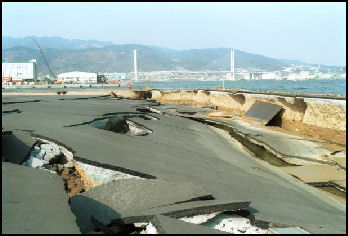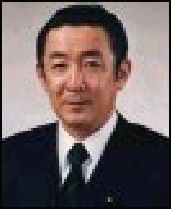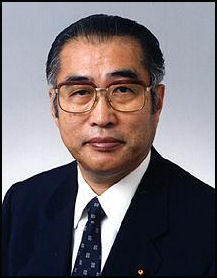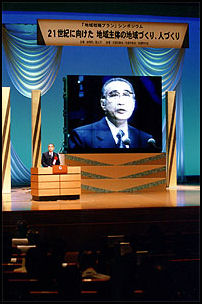SOCIALISTS RULE JAPAN IN THE EARLY 1990s

Murayama There were four prime ministers in 11 months in 1993 and 1994. In 1993, the LDP found itself in big trouble after being blamed for the bursting of the bubble economy and finding itself in numerous bribe scandals. It fragmented and lost it majority in 1993 after defections by party reformists and was ousted by a coalition of reformed-minded parties. It was the first time a non-LDP politician was the prime minister since the end of World War II.
In August 1993, a reformist coalition of eight parties, headed by Prime Minister Morihiro Hosokawa, took power. After making a few reforms, Hosokawa the leader of the Japan New Party, was forced out of office after only eight months over accusations that accepted a $960,000 bribe from a trucking company. Takeshita's and Hosokawa's cases were similar in that they resigned to prevent their problems from adversely affecting Diet deliberations on draft budgets.
Prime Minister Tsutomu Hata lasted only 64 days in office. He is remembered best for his “e-cool” campaign in the mid 1990s when he tried unsuccessfully to convince the nation to wear bizarre and hideous looking safari jackets — made from a light material with strange sleeves that stopped at the elbow — in the summer to reduce the need for air conditioning and save energy.
In 1994, the LPD shocked the nation when they joined a coalition government led by their arch rivals the Social Democratic Party of Japan (SDP, or the Socialists) and the New Party Sakigake. Tomiichi Murayama, the head of the SDP, became Japan's first socialist prime minister since the 1940s. Before taking office he said, "I'm a person who prefers a bit of a tumult in politics to stability. But what is happening now is so un-Japanese."
Murayama came to power with high hopes for reform but he abandoned nearly all his promises and ended up changing the government very little. He made a statement expressing "deep remorse" over Japan's aggression in World War II and was criticized for the slow response of the Japanese government to the Kobe earthquake. Murayama resigned in January 1996 and effectively chose Hashimoto to be his successor.
RELATED ARTICLES IN THIS WEBSITE: MODERN HISTORY factsanddetails.com; JAPAN IN THE 1980s AND EARLY 1990s: NAKASONE AND THE PRIME MINISTERS THAT FOLLOWED HIM factsanddetails.com; JAPAN BECOMES AN ECONOMIC POWERHOUSE IN THE 1970s AND 80s factsanddetails.com; JAPANESE BUBBLE ECONOMY IN THE 1980s AND ITS COLLAPSE IN THE 1990s factsanddetails.com; KOBE EARTHQUAKE OF 1995 factsanddetails.com; AUM SHINROKYO CULT AND THE TOKYO SUBWAY SARIN GAS ATTACK factsanddetails.com; JUNICHIRO KOIZUMI factsanddetails.com; JAPAN'S DECLINE factsanddetails.com
Good Websites and Sources: Essay on Contemporary Japan 1989 to Present aboutjapan.japansociety.org ; Wikipedia article on Nakasone Wikipedia ; Nakasone on Hatoyama New York Times ; Book; The Holy Grail of Macroeconomics, Lessons from Japan’s Great Recession wiley.com/WileyCDA ; Bubble Burst and Recession ? 1990s grips.ac.jp/teacher/oono ; Takazawa Collection at the University of Hawaii on Social Japanese Social Movements takazawa.hawaii.edu ; Documents Related to Postwar Politics and International Relations ioc.u-tokyo.ac.jp ; Japanese History Websites: ; Wikipedia article on History of Japan Wikipedia ; National Museum of Japanese History rekihaku.ac.jp ; Books: “Making of Modern Japan” by Marius Jansen (2000);”Inventing Japan: (1853-1964)” by Ian Buruma (Weidenfeld & Nicholson, 2003). “Embracing Defeat: Japan in the Wake of World War II” by John Dowser of Massachusetts Institute of Technology, who won the Pulitzer Prize for nonfiction in 1999.
RECOMMENDED BOOKS: “The Bubble Economy: Japan's Extraordinary Speculative Boom of the '80s And the Dramatic Bust of the '90s” by Christopher Wood Amazon.com; “Ashes to Awesome- Japan's 6,000-Day Economic Miracle” by Hiroshi Yoshikawa and Fred Uleman (2021) Amazon.com; “Inventing Japan: 1853-1964" by Ian Buruma (Modern Library, 2003) Amazon.com; “The Making of Modern Japan” by Marius B. Jansen Amazon.com; “Japan's Dysfunctional Democracy: The Liberal Democratic Party and Structural Corruption” by Roger W. Bowen (2002) Amazon.com; “The Cambridge History of Japan, Vol. 6: The Twentieth Century” by Peter Duus Amazon.com; “Hirohito and the Making of Modern Japan” by Herbert P Bix Amazon.com; “Embracing Defeat: Japan in the Wake of World War II” by John Dowser of Massachusetts Institute of Technology, who won the Pulitzer Prize for nonfiction in 1999. Amazon.com; “Japan Rearmed: The Politics of Military Power” by Sheila A. Smith (2019) Amazon.com; “Japan in Transformation, 1945–2020 by Jeff Kingston Amazon.com
Kobe Earthquake

The earthquake in Kobe on January, 17, 1995 left 6,425 dead, injured 25,000, displaced 300,000 people, damaged or destroyed 100,000 buildings and caused at least $132 billion worth of damage, making it one of the most expensive natural disasters in history. More than 35,000 people were pulled from collapsed buildings by neighbors or rescue workers. Japanese refer to the disaster as the Great Hansin Earthquake. [Source: T.R. Reid, National Geographic, July 1995]
Beginning at 5:46am, the temblor lasted for 20 seconds, registered 6.9 on the Richter scale and packed a wallop of 240 kilotons of TNT. Over 50,000 buildings were destroyed or badly damaged and 300,000 people were left homeless. A major freeway collapsed, streets were uplifted, and railroad tracks buckled and twisted. Fire raged on and off for two days, and gas and water mains were ruptured.
The earthquake was the worst in Japan since the Great Tokyo Earthquake in 1923, when a earthquake measure 7.9 on the Richter Scale killed 140,000 people, and the greatest disaster in Japan since World War II. It was caused by a strike-slip jolt (sudden lateral movement of one rock mass against another) on the Nojima Fault, which up until then was not considered a dangerous fault.
The epicenter of the earthquake was 40 miles away from Kobe in the Akashi Straight between Awaji Island and Honshu. During the quake the sides of the fault shifted 6 to 10 feet in opposite directions. The surface along the fault moved five feet in one place. This movement could be seen in a rice field on Awaji Island.
There were several reasons why the earthquake was so devastating. First of all the earthquake was very shallow, which means it is more likely to cause extensive damage. Second, Kobe lies in area that many Japanese thought was unlikely to be hit by a major earthquake and thus th residents there were not prepared for a major quake. Kobe is considered one of the nicest cities in Japan and ironically some people even moved there to escape earthquakes.
See Separate Article KOBE EARTHQUAKE factsanddetails.com
Tokyo Subway Sarin Gas Attack
On March 22, 1995, sarin, a lethal nerve gas invented gas invented by the Nazis during World War II, was released by members of Aum Shinrokyo doomsday cult on three Tokyo subway trains during the morning rush hour. The attack left 12 dead, 3,807 seriously injured and sickened thousands of others.
The Tokyo subway attack was reportedly intended by Aum to "set off massive confusion in the Tokyo area" and divert the attention of the police who were believed to be planning a raid of the cult." It was also apparently an effort by cult members to spark the cataclysmic Armageddon that Asahara had predicted and "purify" Japan through global violence.
The poison gas was placed in containers disguised as school lunch boxes and soft-drink containers. It was released simultaneously in five subway cars on three trains heading towards Kasumigaseki, an area of Tokyo where most of the top government agencies have their offices. If the trains hadn’t stopped when the gas was released they all would have arrived at Kasumigaseki station between 8:09am and 8:14am.
Aum leaders gave instructions to perfume the sarin gas, saying "If it smells good like flowers, people will want to inhale it." It has been calculated that if full-strength sarin had been used and disseminated more efficiently, tens of thousands might have been killed.
One of the perpetrators wore sun glasses and s surgical mask (not uncommon in Asia) and boarded the eighth car of a train on the Hibiya line. According to witnesses, he started messing around with a package wrapped in newspapers almost immediately after he boarded the train. At the next stop he set the package on the floor and got off the train. The package started releasing a foul-smelling liquid.
The members of the cult that carried out the crime were reportedly given rice cakes and juice as a reward by Asahara who told them, "Mediate. And chant ten thousand times the phrase, 'This is good, with the blessing of the guru, the great god Shiba and al the victors of truth."
See Separate Article AUM SHINROKYO CULT AND THE TOKYO SUBWAY SARIN GAS ATTACK factsanddetails.com
Ryutaro Hashimoto

Ryutaro Hashimoto was prime minister from 1996 to 1998. A tough, straight-talking ladies man who led two unsuccessful expeditions to climb Mount Everest, he too was welcomed with high hopes. He seemed committed to reforms in the early months of his term but in the end he too accomplished little and failed to solve Japan's economic problems.
Hashimoto was raised in Tokyo. After graduating from prestigious Keio University and working briefly as a salaryman for a textiles company he took over his father seat at the age of 26, becoming the youngest member of the Diet ever, after his father died in 1963. With the help of his politically astute stepmother, Hashimoto won re-election 11 times. His natural mother died when he was 5 months old.
Hashimoto was nurtured in one of the most corrupt wings of the Liberal Democratic Party, served in a number of cabinet posts but made a name for himself by taking a tough stance against the United States in trade negotiations. Hashimoto once said that U.S. Trade Representative Mickey Kantor was "even more aggressive than my wife when I come home drunk." He was regarded as an expert on economic policy and had reputation for working well with bureaucrats and knowing when its important to strike out on his own.
Hashimoto, the Ladies Man
Middle-aged women found Hashimoto attractive. In 1990, a former girlfriend revealed intimate details about their relationship in a magazine interview. "He was so Americanized, very much a gentleman," she said. "He hung my coat, let me sit first" and then added "Oh, he was passionate."
Hashimoto was linked with a television newscaster, a female legislator, a bar hostess and a Chinese interpreter whose husband found out their affair and made a stink. His liaisons didn’t hurt his political career too much. According to an old saying, "scandals below the belly button don't really matter." Hashimoto's only comment on the subject was that he has "fallen in love in the past."
Hashimoto was once voted as one of Japan’s best dressed men. His wife, however, said he was not so well dressed at home. She told Newsweek that he liked to sit around the living in boxer shorts reading manga comic books.
Hashimoto had five children. His wife Kumiko was a tireless campaigner who once said that she had her doubts that her husband was "really that popular among the ladies." Describing her relationship with her husband, she said, "I give way to him as if he were a feudal lord, with everything done as he wishes."
Hashimoto as Prime Minister
Hashimoto served as prime minister from January 1996 to July 1998. He took power after forming a coalition with two parties led by women: Takado Doi of the Socialist Party and Akiko Domoto of the New Party Sakigake.
Hashimoto promised reforms at a time when Japan needed reform and Asia was crippled by the Asian financial crisis. He passed few reforms and Japan's economy came very close to collapsing while was prime minister. Hashimoto is remembered most for the bankruptcies of two giant companies — Yamaichi Securities (Japan's forth largest broker) and Hokkaido Takushoku Bank — in late 1997.
Hashimoto's reforms were defeated by party politics and bureaucratic errors. He had a few minor successes in relaxing regulations and streamlining the government administration. On the diplomatic front he struck a deal with the United States to return land used by a military base in Okinawa.
Hashimoto was ousted in July 1998 after being blamed for the poor showing his party in upper house elections. He continued to serve as a member of parliament. In the early 2000s he was involved in a corruption scandal. He died in July 2006 at the age of 68 of multiple organ failure after being diagnosed a month earlier with an intestine disease and having a large section of large intestine removed. .
Keizo Obuchi

Keizo Obuchi was the prime minister of Japan from July, 1998 until his death in May 2000. A former foreign minister, he took office after Hashimoto stepped down in the midst of an economic crisis and was largely expected to be a caretaker who would last a few months at most. After he took office the political analyst John F. Neuffler said he had "all the pizzazz of cold pizza."
Obuchi was born in Gumma prefecture (northwest of Tokyo) in June, 1937. He graduated from Waseda University with a degree in literature and inherited his seat in the lower house from his father. He first took office at the age of 26 and was elected 12 times.
In 1979, he occupied his first cabinet position. In 1987 he was selected as cabinet secretary; in 1991 he became the LDP's secretary general (the third highest position in the party) under Kaifu. In 1994, he became head of the LDP's largest faction and was picked as foreign minister, a position regarded as the stepping stone to the premiership, in 1997.
Obuchi was regarded as so dull and an uncharismatic he was known as "Mr. Ordinary Ma" in his own party. He was not above playing dumb to skirt discussion in sensitive issues. The New York Times described Obuchi is "an unusually nice and unpretentious man" who "cheerfully pokes fun at his lack of star quality, portraying himself as short on talent but long on determination." Obuchi once told people in his hometown, "I am a mix of three things: good luck, dullness and perseverance."
One political analyst told the Washington Post, "He has a very shrewd sense of who is with him, what those people want and how their influence can be bought. In other words, he is a born politician in the mold of Lyndon Johnson."
Obuchi as Prime Minister

Obuchi surprised every one by showing great organizational and consensus-building skills as prime minister. He forged an alliance with the small Liberal Party and the New Komeito Party (the political arm of a controversial Buddhist sect) and united factions within the LDP. He was able to rescue Japan from the brink of economic collapse by pushing through a $200 billion stimulus package and distributing shopping coupons — in which every family in Japan with children under 15 was given about $180 in coupons which they cou;d spend like money — to encourage people to spend money.
Obuchi is also remembered for apologizing to the South Korean president over the Japanese occupation of Korea between 1910 and 1945, giving the Japanese miliary a higher profile after North Korea tested a missile that could reach Japan, and passing legislation that made the Japanese flag and national anthem official symbols of the country. On the negative side there were a number of scandals involving members of his party.
During his tenure his rating in opinion polls steadily rose from the high teen after he took office to 51 percent in the summer of 1999. Neuffer later said, "I have to change my view on him, in that he has grown in the job and been fairly effective.”
Obuchi's Death
Obuchi was hospitalized at 1:00am on April 2, 2000 after he seemed out of sorts and had difficulty speaking. At the hospital it was determined he had suffered a stroke. Later he lapsed into a coma. He died on May 14 at the age of 62. Over 6,000 people attended his funeral, including Crown Prince Naruhito, Princes Masako, U.S. President Bill Clinton, South Korean President Kim Dae Jung and the leaders of the Philippines, Indonesia and other countries.
Before his stroke Obuchi was exhausted from dealing with a major volcanic eruption in Hokkaido and disputes with one his coalition partners, the Liberal Party. It was said that Obuchi probably took no more than three days off during his 20 months in office. After his death his daughter took over his seat.
After Obuchi disappeared from public view, details of his condition were veiled in secrecy. An announcement about his health was not made until 22 hours after he was hospitalized and even then government officials only said Obuchi was in intensive care. After that there was a news blackout. No doctors commented on his condition. The process to determine his successor took place behind closed doors.
Yoshiro Mori
Yoshiro Mori became Prime Minister in April, 2000 while Obuchi was still in a coma. Incredibly inept, he is remembered mostly for angering people with flippant remarks and playing golf rather than doing his job. He only lasted about a year in office before her was forced to resign in April 2001 after barely surviving a no confidence vote.
Mori was born on July 14, 1937 in Ishikawa Prefecture in northern Japan. Both his father and grandfather were active in local politics. Mori attend Waseda University and was a classmate of Obuchi. He began his career as a newspaper reporter for a leading Tokyo-based daily, the Sankei Shimbun, in the early 1960s.
Mori had ambitions of being a big time rugby player. He was the captain of his rugby team in high school but didn't make his team at college. He continued the play after he graduated . In his autobiography he wrote, "Life is like a rugby ball. You never know which way it will bounce."
Mori's Political Career

Mori Mori entered Parliament as an independent in 1969. He joined the LDP once in office and was known as something of a loose cannon. Once he offended a rival politician so much he was thrown off his campaign truck and had to walk home.
Mori was one of 11 Diet members implicated in the Recruits stock-for-favors scandal. He acknowledged earning $1 million in the deal and was investigated on bribery charges but not was indicted. He was also linked with other financial scandals and criticized for speaking at a wedding in 1995 attended by Yakuza members. There were also rumors that he was arrested with prostitutes while he was a college student.
Mori headed the Education and International Trade Ministries and served in three top executive posts of the LDP: general council chairman, policy research council chairman and secretary general. In 1998, he became head of his own faction, which became the LDP's third largest faction.
In Parliament Mori was called "an elephant with a fleas' heart," a reference to hissize and indecisiveness and was known for his racist remarks and slips of the tongue. After the Los Angeles riots in 1992, Mori said that the large number of Koreans in Japan "could form an army." He also said that farmers in his district "went inside their homes as if an AIDS patient was coming" in reference to a low turnout for his appearances. When he was named prime minister, one political rival said, "We'll let him talk and talk and talk. Eventually his tongue will slip."
Mori as Prime Minister
Mori was selected as prime minster in closed-door meetings in smoke-filled rooms involving the major players in the LDP. It is unclear how or why he was chosen but is many thought it was because his loyalty to Obuchi and connections to the LDP's coalition partners.
Mori was fond of spending at least a couple nights a week in “ryotei”, traditional inns made up of a mazelike configuration of private, screened rooms, where businessmen and politicians met to make deals while being entertained by geisha.
Mori was criticized for continuing to play golf and not returning immediately to his office after being informed that nine Japanese died on the fishing boat “Emihi Maru” that was sunk by an American submarine. Later it was revealed that Mori had been given an ultra expensive membership to a private golf club by an executive with a large company.
There were also a number of scandals involving members of Mori's cabinet and party. He snubbed the king of queen of Norway by skipping a state banquet held in their honor and opting to eat sushi with some of his colleagues instead.
Soon after taking office Mori caused a stir when remarked that Japan is "a divine country with an emperor at its center." This comment gave shivers to people who associated it with the kind of nationalism found in Japan before World War II.
On the eve of an election he said, "I'd feel comfortable if voters with no particular parties to support stay in bed on the day of the general election."
Mori's approval rating dropped from 42 percent when he took office to 8 percent (with a disapproval rating of 82.4 percent) near the end of his term. He finally resigned in April 2001. Most Japan wished he had resigned earlier.
Image Sources: Kantei office of Japanese Prime Minister, Wikimedia Commons
Text Sources: New York Times, Washington Post, Los Angeles Times, Daily Yomiuri, Times of London, Japan National Tourist Organization (JNTO), National Geographic, The New Yorker, Time, Newsweek, Reuters, AP, Lonely Planet Guides, Compton’s Encyclopedia and various books and other publications.
Last updated September 2016
